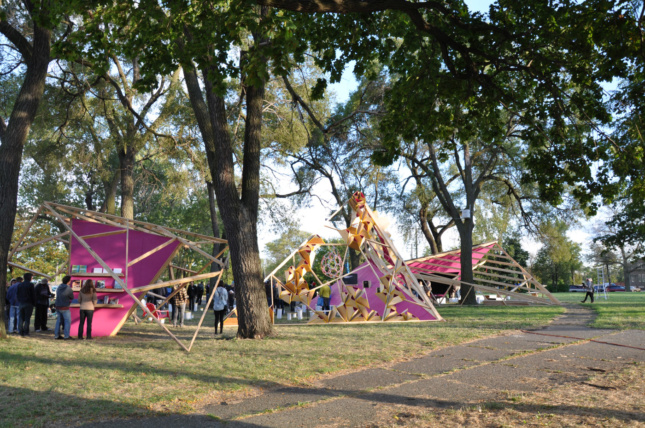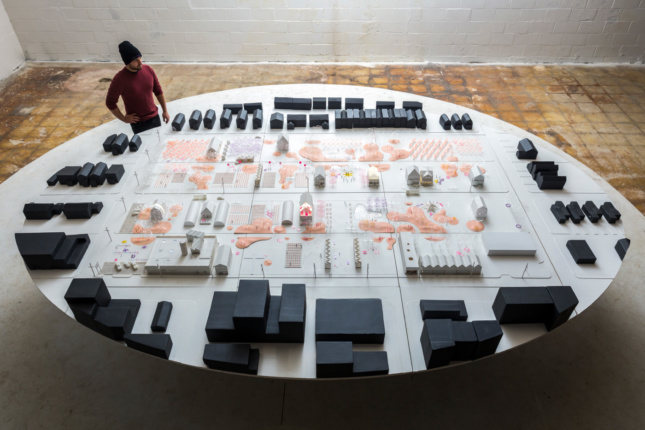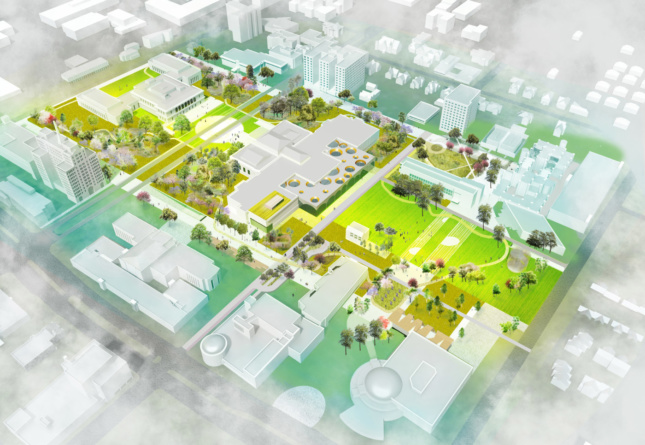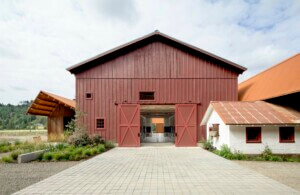Upon their arrival to Detroit, partners Anya Sirota and Jean Louis Farges took four years to understand the complex landscapes and narratives that co-exist within the city. At the time, Detroit was fully entrenched in “ruin porn” and the design interest of the city followed a fascination with degradation or a re-imagination to building new. Cultural assets (like the industrial design of cars and jazz music) once thrived in the city and continue to have national and international range. Often though, the direct impact upon the residents is nonexistent.
Akoaki [pronounced ak-o-ak-i] is compelled to research fields of architecture and art and their relationships to equitable redevelopment. By embracing the power of aesthetics and form-making, the couple peels away normative tropes of social practice. Beginning with aspirations to include aesthetics, beauty, and pomp creates pieces that do not comply with age. Often feeling burdened by good taste, Akoaki’s aesthetic quality tries to be bigger and badder.

Imaging Detroit
Supported by a Research on the City grant from the University of Michigan’s Taubman College of Architecture & Urban Planning, Imaging Detroit is, in a nutshell, an international film festival and pop-up agora. The project investigates the many ways Detroit has been portrayed over the last decade, be it film or publications. Sirota and Farges, along with a suite of collaborators, researched the way people construct narratives around the city and responses to those narratives. A major challenge of the project was how to stage an event in this context without contributing to a proliferation of ruin porn and social degradation. The goal was to create true conversation and a positive impact while staging a public debate and open speculation. The 36-hour event transformed Perrien Park into a civic space with screenings, conversations, exhibitions, food, and leisure—a true ephemeral urbanization.

Detroit Cultivator
In collaboration with the six-acre Oakland Avenue Urban Farm (OAUF), Akoaki is designing a master plan that combines agriculture, culture, business, and ecology to envision a landscape that is both economically and ecologically sustainable. The project required navigating through major issues regarding land ownership, pressure from developers, and water access. After working with the University of Michigan Law School and a team of “moral investors” to secure the land, a business plan was created with volunteers from the University of Michigan Ross School of Business. The plan prioritizes the farm’s productivity to create a source of income and a flexible space for neighborhood entrepreneurs. As a result, the master plan features existing structures that will eventually become public amenity spaces; for example, a shoe-shine parlor will reopen as a multi-tenant commercial space and performance venue. Rather than keeping the farm purely agricultural, Sirota and Farges sought to activate other existing uses through building and site interventions. The project is an experimental urban prototype, though Akoaki is working to ensure the farm can become a permanent fixture in the neighborhood.
Sirota and Farges’s experience working on Detroit Cultivator has set them up to discover a similar food-related project, this time in Mississippi. Supported by a $1 million public art grant from Bloomberg Philanthropies, “Fertile Ground: Inspiring Dialogue about Food Access” brings together architects and artists with chefs, gardeners, food policy experts, and local institutions to facilitate a year of community-engaged interventions. Ultimately, the project aims to establish a nonprofit research lab on food access that will operate on a permanent basis to sustain the momentum that is created. While Mississippi is known for its agriculture, a majority of the food grown in the state leaves, and Jackson is full of “food swamps”—a plethora of fast food options as opposed to fresh food. Rather than return to the “idyllic” past of farming (an image that is not necessarily representationally positive to everyone), Akoaki has formulated a “neo-rural” environment that deserves an aesthetic value and brings together aspirations of the city.

Midtown Cultural Center
Detroit’s Midtown Cultural Connections organized a year-long competition in an effort to connect Detroit’s most significant cultural institutions. The winning entry includes Akoaki and their assembled team of landscape architects, urban planners, and technology-experts. The announcement of the winning proposal displays how Detroit’s participating institutions and stakeholders carry a willingness in allowing an open-ended framework a chance to succeed. The plan that Akoaki and team are working on will take issues of mobility, environmental sustainability, and stormwater stewardship into consideration. Overall, the project requires a sensitivity to placemaking in order to avoid displaced cultural queues and gentrification. When finished, the project will create a unified, dynamic, and inclusive space that facilitates connections between the Cultural Center and the Midtown neighborhood.











